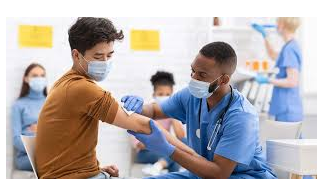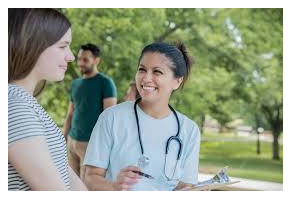Community Resources
Community Resources
1. Identify Community Resources for Clients
Introduction to Community Resources
Community resources are services, programs, and supports available to individuals and families within a given community. These resources are often provided by governmental agencies, non-profit organizations, or healthcare systems and aim to promote the health and well-being of community members. They play an essential role in nursing practice by ensuring that patients have access to the necessary care, support, and education to promote health and prevent illness.
Types of Community Resources

i. Healthcare Services:
- Primary Care Providers: General practitioners, nurse practitioners, and physician assistants who provide first-line medical services.
- Specialty Services: Cardiology, oncology, pediatrics, and mental health services offered within the community.
- Community Clinics: Local clinics that offer affordable or sliding scale payment options, often for uninsured or underinsured clients.
- Emergency Medical Services (EMS): Emergency response teams that provide immediate care in crises.
- Hospital Services: Many community hospitals offer emergency services, outpatient care, and specialized units like intensive care or birthing centers.
ii. Social Services:
- Social Workers: Offer counseling and help clients navigate social systems such as welfare, child protection, and financial assistance.
- Community Outreach Programs: These programs are often run by non-profit organizations or local governments and offer help with housing, food, legal aid, and financial assistance.
- Substance Abuse Programs: Resources for individuals struggling with drug or alcohol addiction, offering counseling, group therapy, and rehabilitation services.
- Mental Health Resources: Community mental health centers provide psychological and psychiatric services, counseling, crisis intervention, and rehabilitation for those with mental health disorders.
iii. Public Health Resources:
- Immunization Clinics: Local clinics that offer free or low-cost vaccinations for children and adults.
- Health Departments: Local or state health departments provide public health services, disease prevention, and health education.
- Women, Infants, and Children (WIC): A supplemental nutrition program for low-income pregnant women, breastfeeding mothers, and children under five.
iv. Support Networks and Advocacy Groups:
- Support Groups: Local or virtual groups for people with chronic conditions such as diabetes, cancer, or heart disease.
- Chronic Disease Management Programs: These include lifestyle counseling, educational resources, and structured programs for clients managing long-term health issues.
- Advocacy Groups: Nonprofit organizations that advocate for the rights of specific populations (e.g., Alzheimer’s Association, American Cancer Society).
v. Transportation Services:
- Non-Emergency Medical Transportation (NEMT): These programs help clients who cannot access medical services due to transportation barriers.
Assessment of Community Resources
As a nurse, assessing available community resources involves understanding local, state, and national support systems and how they can be utilized by the client. Nurses need to consider factors such as:
- Client’s Geographic Location: Rural, urban, or suburban settings may have different resources available.
- Client’s Financial Situation: The client’s financial health may dictate their access to specific programs, such as sliding scale or low-cost healthcare.
- Client’s Social and Family Support: The resources available to clients may vary depending on the support they receive from family and social networks.
Nursing Interventions for Identifying Community Resources
- Comprehensive Client Assessment: Assess the client’s health needs, socioeconomic status, cultural preferences, and geographical location. This allows the nurse to identify specific resources that the client may benefit from, such as transportation services, financial aid, or specialized health care.
- Referral Services: Based on the assessment, refer the client to appropriate community resources. For example, a client with diabetes may benefit from a diabetes education class, while a pregnant woman may need WIC services.
- Collaboration with Social Services: Work in collaboration with case managers and social workers to connect clients with resources, ensuring that they have the necessary support to manage their health condition.
2. Assist and/or Participate in Community Health Education

The Role of Nurses in Community Health Education
Community health education is essential in promoting public health by increasing the population’s awareness of health issues, preventive measures, and available resources. Nurses are integral to this process due to their role in patient education, health promotion, and disease prevention.
Principles of Community Health Education
- Health Literacy: Ensuring that the community understands health information, including basic health concepts, terminology, and resources. Nurses must tailor their education to the client’s literacy level and cultural background.
- Preventive Education: Focus on the prevention of diseases and health conditions, such as providing information on healthy eating, regular physical activity, vaccination, and tobacco cessation programs.
- Promoting Healthy Behaviors: Nurses help individuals and groups develop healthier lifestyle habits, such as exercise, nutrition, stress management, and substance abuse prevention.
- Cultural Competency in Health Education: Ensure that health education is culturally sensitive. This involves understanding the cultural norms and values of the community and adapting the health messages accordingly.
Types of Community Health Education
- Health Fairs and Screenings: Nurses can organize or participate in health fairs to provide health screenings for blood pressure, cholesterol, glucose levels, and other preventative services.
- Workshops and Classes: Community health education may take the form of classes, workshops, or group meetings. For instance, a nurse could lead a class on proper nutrition, parenting, or disease prevention strategies.
- Home Visits: Nurses can conduct home visits to provide individualized health education to clients who are unable to attend community health events.
- Public Campaigns: Nurses can participate in public health campaigns to raise awareness about pressing health issues (e.g., smoking cessation, vaccination drives, or heart disease prevention).
Nursing Interventions for Health Education
- Assess Educational Needs: Begin by assessing the community’s health education needs. This may involve surveys, focus groups, or interviews to understand the health issues facing the population and the most effective ways to educate them.
- Provide Information on Available Resources: Educate the community about local resources, such as free health clinics, financial aid programs, and mental health services.
- Use Multiple Educational Methods: Use various teaching methods to reach different learning styles. This might include printed pamphlets, online resources, interactive workshops, or one-on-one counseling.
- Collaborate with Community Leaders: Partner with community leaders or organizations that are trusted within the community to help disseminate health information effectively. These leaders can be instrumental in gaining the trust of the population.
3. Reinforce Teaching with Clients About Health Risks Based on Family, Population, and/or Community Characteristics

Health Risks Based on Family, Population, and Community Characteristics
Health risks can vary based on familial history, population demographics, and environmental factors. Nurses need to understand how these factors influence an individual’s health to provide tailored education and interventions.
Family-Based Health Risks
- Genetic Conditions: Certain genetic conditions run in families, such as cystic fibrosis, sickle cell anemia, and hereditary breast cancer. Family members should be educated on how to recognize early signs, seek testing, and participate in preventive care.
- Chronic Diseases: Family history of chronic diseases like hypertension, diabetes, and cardiovascular disease increases the risk of these conditions in the client. Nurses should reinforce the importance of lifestyle changes, such as maintaining a healthy weight, exercising, and eating a balanced diet.
- Mental Health: Family histories of mental health disorders (e.g., depression, anxiety, schizophrenia) require special attention. Nurses should educate family members about recognizing early signs of mental health issues and how to access counseling or support services.
Population-Based Health Risks
- Age-Related Health Risks: Different populations are at risk for age-specific conditions. Children may be at higher risk for infectious diseases and developmental delays, while older adults may face conditions like arthritis, osteoporosis, and cognitive decline. Health education should be tailored accordingly, with specific guidance for various age groups.
- Socioeconomic Status: Clients from lower socioeconomic backgrounds may be at greater risk for certain health problems due to limited access to healthcare, nutritious food, and safe living environments. Health education should address these disparities, including promoting resources like free clinics and food banks.
- Cultural Factors: Cultural beliefs and practices play a role in health behaviors. Nurses should consider these factors when educating clients. For example, some populations may not seek medical care due to cultural taboos or fear of discrimination.
Community-Based Health Risks
- Environmental Factors: Communities in polluted or industrial areas may face increased risks for respiratory illnesses, cancers, or other diseases caused by environmental toxins. Nurses should educate these communities about reducing exposure and seeking early detection of disease.
- Epidemiological Trends: Certain communities may have higher rates of specific diseases due to genetic factors or historical health patterns. For example, communities with high numbers of African Americans may have increased rates of hypertension, while Native American populations may have higher rates of diabetes.
- Access to Healthcare: Communities with limited access to healthcare services face greater health risks. Nurses should reinforce the importance of preventive care, educate clients on available community resources, and advocate for improved healthcare access.
Nursing Interventions for Reinforcing Health Risk Education
- Genetic Counseling and Family Health History: Reinforce the importance of gathering a comprehensive family health history and discussing genetic testing options with healthcare providers.
- Lifestyle Modifications: Provide targeted education about lifestyle changes to reduce risk factors, such as diet, exercise, smoking cessation, and alcohol use.
- Health Screenings: Encourage regular health screenings based on family history, such as mammograms, cholesterol tests, blood pressure measurements, and colonoscopies.
- Support for Mental Health: Reinforce the importance of mental health care, especially for clients with a family history of mental health issues. Educate clients about available mental health services, coping mechanisms, and stress management.
- Culturally Appropriate Resources: Provide educational materials and resources that are culturally sensitive and consider language barriers. Nurses should also ensure that clients have access to health services in their preferred language and culturally competent care.
Conclusion
This in-depth examination of community resources, health education, and the reinforcement of teaching about health risks based on family, population, and community characteristics demonstrates the broad and vital role nurses play in promoting community health. By identifying, assisting with, and educating clients about available resources and health risks, nurses empower individuals and families to make informed decisions about their health, leading to better outcomes for communities at large.
